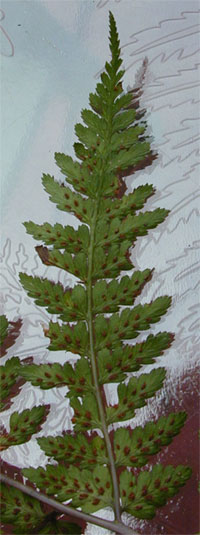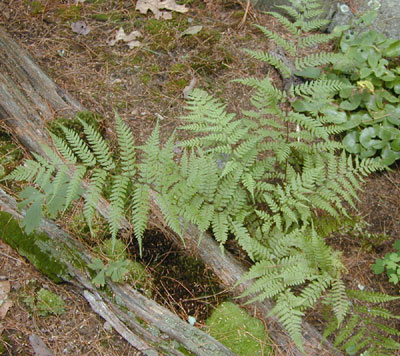|
Hardy Fern Home A. vidalii resources
All Ferns � Woodsiaceae �� Athyrium
�Other Genera
|
| Athyrium vidalii | ||
|
Etymology
Named after the unknown-to-us person whose name was Vidal.
Description
Rhizome: erect.
Frond: 100 cm high by 40 cm wide, deciduous, monomorphic, blade/stipe ratio: 1:1. Stipe: dark brown at swollen, laterally spinous base, red-purple above, old stipe bases persistent, scales linear to lanceolate, 8--12 mm long, 1 mm broad, light brown to brown, vascular bundles: 2, lunate, uniting to a U-shape above. Blade: 2-pinnate-pinnatifid at the base, less upwards, triangular, abruptly narrowed tip above the dozen pinnae pairs, herbaceous, vivid green, glabrous. Pinnae: 10 to 12 pair, short-stalked, lanceolate, long-pointed at apex; pinnules lanceolate, to 3 cm.; costae grooved above, continuous from rachis to costae; spines present (not visible in photos above); margins serrate to lobed. Sori: elongate, lunate or hooked, horseshoe-shaped, the base next to the costule, indusium: shape as for sori, whitish. Culture
Habitat: woodland in mountains.
Distribution: Japan, China, Korea.
Hardy to -25�C, USDA Zone 5.
Distinctive Characteristics
The darkly colored stipe is similar to that of A. otophorum, but shades to green mid-rachis; this is also more divided, at least at the base. Distinguishing this from a non-'Pictum', i.e., the straight species form of A. niponicum is more difficult. This has shorter pinna stalks at the base (1 cm or less vs. 1 cm or more in niponicum) and the pinnae become sessile rapidly up the blade (vs. near the apex in niponicum). A. vidalii's stipe is brown at base, then red-purple, diminishing upwards to green mid-rachis and A. niponicum is reddish at base, quickly green mid-stipe, then sometimes coloring red in the rachis. The ultimate segments of A. vidalii are serrate, but blunter than the finely toothed A. niponicum. In the final analysis, given the wide variation, one must take all the factors into consideration.
Synonyms
Asplenium vidalii Franch. & Sav Athyrium glabrum Ching Athyrium glabrescens Ching |
|
|

Athyrium vidalii. Fertile pinna. Rachis is red-purple, but the camera has decided on gray. Venation and more detail on the click-through. �Photo: Tom Stuart |
